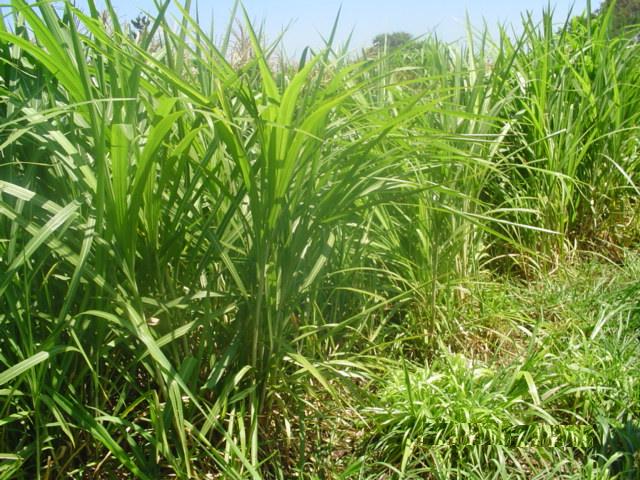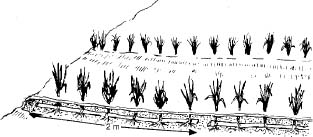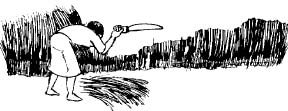|
|
Napier Grass

|
Planting Napier grass for fodder Napier grass is an improved fodder grass that produces
a lot of high-protein forage. It is also known as "elephant
grass", "Sudan grass" or "king grass". Its
scientific name is Pennisetum purpureum.
Location
Napier grass is best suited to high rainfall areas, but
it is drought-tolerant and can also grow well in drier areas. It does not
grow well in waterlogged areas. It can be grown along with fodder trees
along field boundaries or along contour lines or terrace risers to help
control erosion. It can be intercropped with crops such as legumes and
fodder trees, or as a pure stand.
Advantages
- Napier grass is propagated easily.
- It has a soft stem that is easy to cut.
- It has deep roots, so is fairly drought-resistant.
- The tender, young leaves and stems are very palatable for livestock.
- Napier grass grows very fast.
Disadvantages
- Napier grass is an aggressive plant that spreads through rhizomes
under the ground. If it is not controlled, it can invade crop fields
and become a weed.
- The older stems and leaves are less palatable for livestock.
Requirements
- Planting materials.
- Rope, hoe, wheelbarrow, tape-measure or measuring stick with marks
at 60 cm and 90 cm (2 feet and 3 feet).
- Manure.
Procedure
Napier grass can be planted using three different
methods: by cuttings, "slips" or whole stems.
Planting cuttings
1. At the beginning of the rains, collect the planting
materials. With a sharp knife, cut the bottom part of young Napier grass
stems into pieces. Each piece should have at least three nodes (the knobs
or swellings on the stem).
|
|
 2.
Stretch out a rope across the plot to make sure you have a straight line.
Using the hoe and measuring stick, plant the pieces of stem at 60 cm
intervals along the line. Plant them angled into the ground at about 30
degrees, so two of the nodes are buried in the soil and one is above the
ground. 2.
Stretch out a rope across the plot to make sure you have a straight line.
Using the hoe and measuring stick, plant the pieces of stem at 60 cm
intervals along the line. Plant them angled into the ground at about 30
degrees, so two of the nodes are buried in the soil and one is above the
ground.
3. Plant more rows with a spacing of about 90 cm (3
feet) between the rows.
Planting "slips" or "splits"
If you planting "slips" or
"splits", you do not have to wait a long time for the grass to
grow before you can multiply it. Seedlings from the slips become
established more quickly than those grown from cuttings.
1. Cut Napier grass stems at ground level to remove all
the green material.
2. Dig up the clump of roots and shoots growing under
the ground.
3. Separate each seedling from the clump. Each seedling
must have both roots and a shoot.
4. Trim the roots to about 5 cm (2 inches) long.
5. Plant the seedlings in small holes or a furrow.
6. Cover the roots with soil, but leave the shoots open
to the air.
Planting whole stems
Planting whole stems is useful during the heavy rains,
and in hilly areas where you need the grass to sprout quickly to cover the
ground. Plant them along the contour to control erosion.

1. Cut whole young stems of Napier grass, about 2 m (6
feet) long.
2. Put the stems end-to-end in a furrow, and cover them
with soil.
|
Maintenance and harvesting
1. Water immediately after planting.
2. Weed the Napier grass plot regularly.
3. If any of the cuttings die, fill in the gaps with
new ones.
4. Harvest the grass when it is 90_120 cm (3_4 feet)
high. Harvest the grass following a pattern. Beginning at one end of the
row, cut enough grass to feed your animals for 1 day. The next day, cut
the next grass along in the row. Carry on until you reach the end of the
row. In this way, you will always be able to cut fodder for your
livestock.

5. Apply liquid manure by digging trenches in between
the rows of grass. Pour liquid manure into the trenches (see the section
on Urine_manure slurry as fertilizer for details).
6. If the livestock do not eat all the grass, use the
remainder as mulch or compost.
Do's
- Cut the grass 15_25 cm (6_10 inches) above the ground. Some
farmers have found it is better to cut at ground level, though
this may damage the plant too much.
- Fill in any gaps in the rows with fresh cuttings.
|
Don'ts
- Don't use older stems as planting materials, as they will
not germinate well.
- Don't intercrop with cereals, as the grass will compete with
the crop for nutrients and light.
- Don't allow animals to graze on the Napier grass, as they
may damage or kill the plants.
- Don't allow the grass to overgrow, as it may become a weed.
- Don't allow the grass to grow too high (more than 120 cm or
4 feet), as livestock will not eat it.
|
|
| |
|
As % of dry matter |
| |
DM |
CP |
CF |
Ash |
EE |
NFE |
| Fresh, pasture, fertilized, Puerto Rico |
25.6 |
9.0 |
36.5 |
7.8 |
3.0 |
44.7 |
| Hay, leaves, prebloom, 60 cm, Lao |
90.5 |
13.8 |
32.3 |
7.4 |
4.1 |
42.4 |
| Hay, stem, prebloom, 60 cm, Lao |
89.6 |
10.5 |
33.7 |
10.2 |
3.1 |
42.5 |
| Hay, late vegetative, India |
91.2 |
4.4 |
37.8 |
8.8 |
1.0 |
48.0 |
| Hay, mid-bloom, India |
91.3 |
4.2 |
36.8 |
10.1 |
1.1 |
47.8 |
| Stem-cured, Kenya |
88.9 |
6.1 |
32.3 |
8.4 |
1.7 |
51.5 |
Perennial grass, culms usually decumbent, viscid-glandular throughout, rooting
at lower nodes, up to 1.8 m long, forming spreading tufts; leaves 5–17.5 cm
long, 4–13 mm broad, minutely to densely hairy, the hairs viscous with
characteristic somewhat sweet odor, purple or red-brown, sheaths pilose, panicle
open in flower, closing at maturity, becoming dense and narrow, 10–30 cm long,
usually pale pink to purple, with fine ascending filiform branches; spikelets
numerous, ca 2 mm long, light green or purple, hairless, with 2 florets, only
the upper one fertile; lower glume in form of tiny scale; upper glume as long as
spikelet; valve of lower sterile floret similar in appearance to upper glume but
with fine purple awn 6–15 mm long. Fl. November.
Reported from the African Center of Diversity, molasses grass, or cvs thereof,
is reported to tolerate drought, fire, insects, laterite, low pH, poor soil,
slope, and weeds. Not resistant to fire or waterlogging. There is wide variation
in growth habit, hairiness, leafiness, and vigor. (2n = 36) (Duke, 1978;
Gohl, 1981.)
Indigenous to Africa; introduced to South America, Assam, southern India, and
elsewhere. In Kenya, in certain isolated areas, mostly in scattered tree
grasslands. Cited as a weed in Brazil, Colombia, Hawaii, and Venezuela (Holm et
al., 1979).
Ranging from Subtropical Dry to Wet through Tropical Very Dry to Moist Forest
Life Zones, molasses grass is reported to tolerate annual precipitation of 6.4
to 27.8 dm (mean of 16 cases = 16.3), annual temperature of 18.3 to 26.6°C
(mean of 16 cases = 23.5), and pH of 4.5 to 8.4 (mean of 11 cases = 6.1) (Duke,
1978, 1979). Usually occurs on rocky ground in hilly country, sometimes forming
pure stands. Succeeds throughout warmer, high-rainfall regions of Africa from
sea level to about 2,170 m altitude. Under proper pasture management it forms a
close sward. Grows in both moist and dry areas.
Seed production is good and establishment from seed is relatively easy.
Propagated from cuttings, the plants are quick growing because of their
spreading and rooting habits. They smother out weeds, producing a close herbage
suitable for pasturing cattle.
Crop may be harvested 50 days after planting seed. It may be used for pasture or
may be cut and used for fodder later. This grass is susceptible to overgrazing.
Duke (1978) reports hay yields up to 43 MT/ha. Trials in India gave yields of
29–48 tons green herbage/ha in 2 or 3 cuttings. Cultivated fodder in India,
Brazil, and Africa; mainly used locally where grown.
According to the phytomass files (Duke, 1981b), annual productivity ranges from
2 to 16 MT/ha (2–16 in Colombia, 4–8 in Costa Rica).
Following fungi have been reported on molassesgrass: Claviceps sp.,
Corticium solani, Fusarium graminearum, F. sambucinum, Phyllachora graminis, P.
melinicola, Uredo melinidis, Uromyces setariaeitalicae. Nematodes isolated
from this grass include: Helicotylenchus dihystera, Hemicriconemoides
cocophilus, Meloiodgyne javanica, Peltamigratus nigeriensis, and
Scutellonema clathricaudatum.
KARI
I Rothamsted
Research I NARO
I Ministry
of Agriculture, TanzaniaI
Ministrty of Agriculture, Kenya I NALEP I KAPP
I
Webmaster
Copyright
© 2007 icipe - African Insect Science for Food and Health
|

